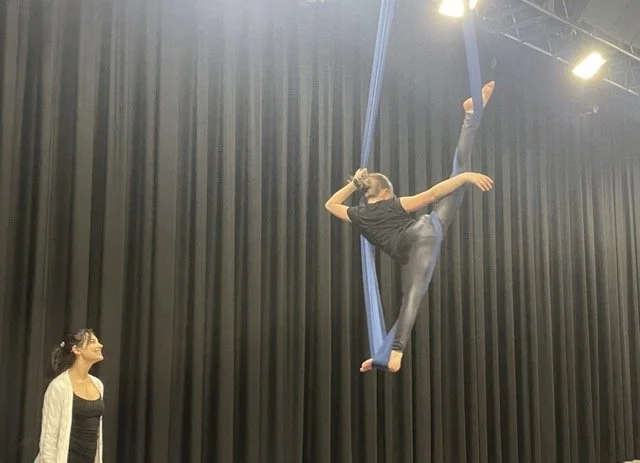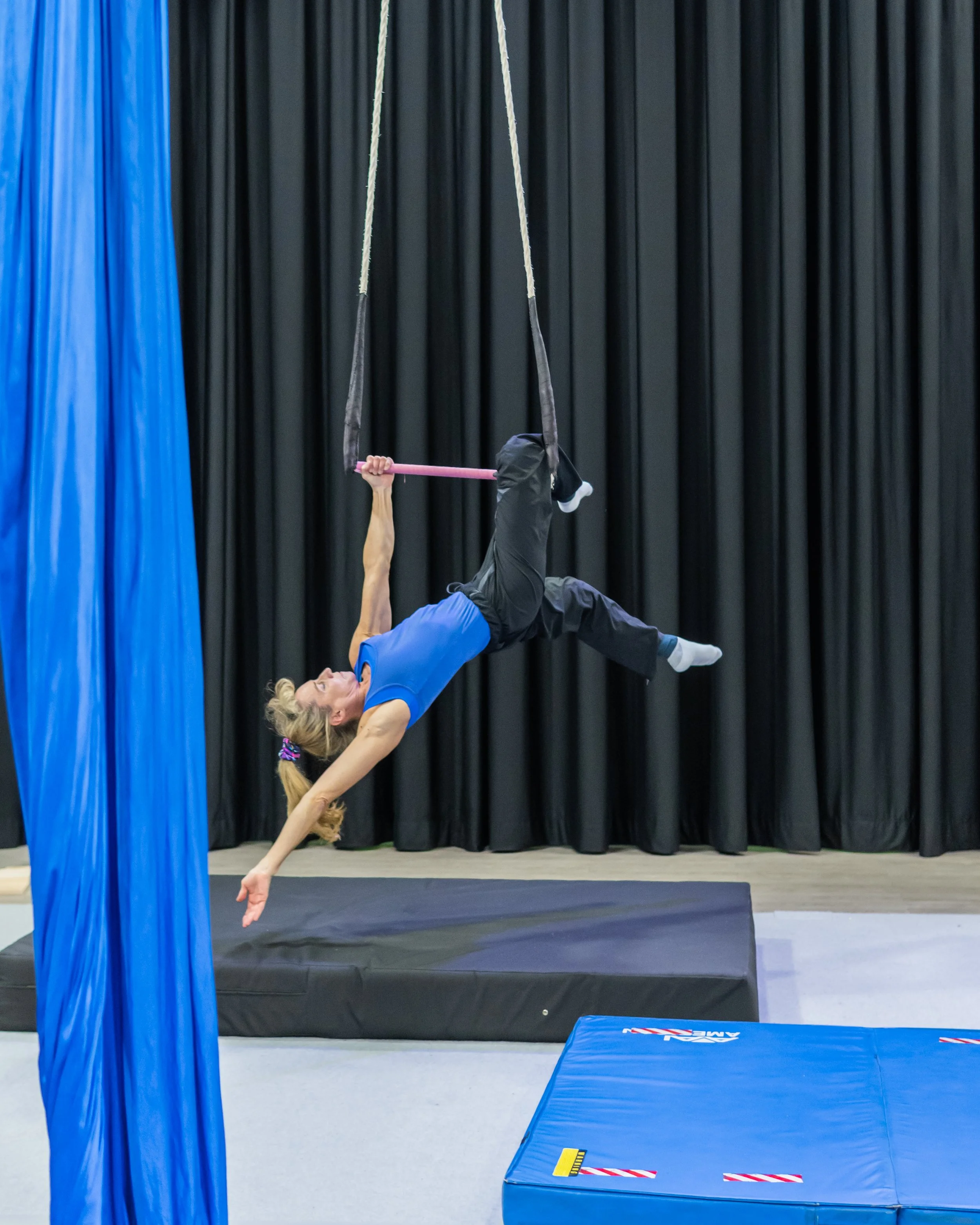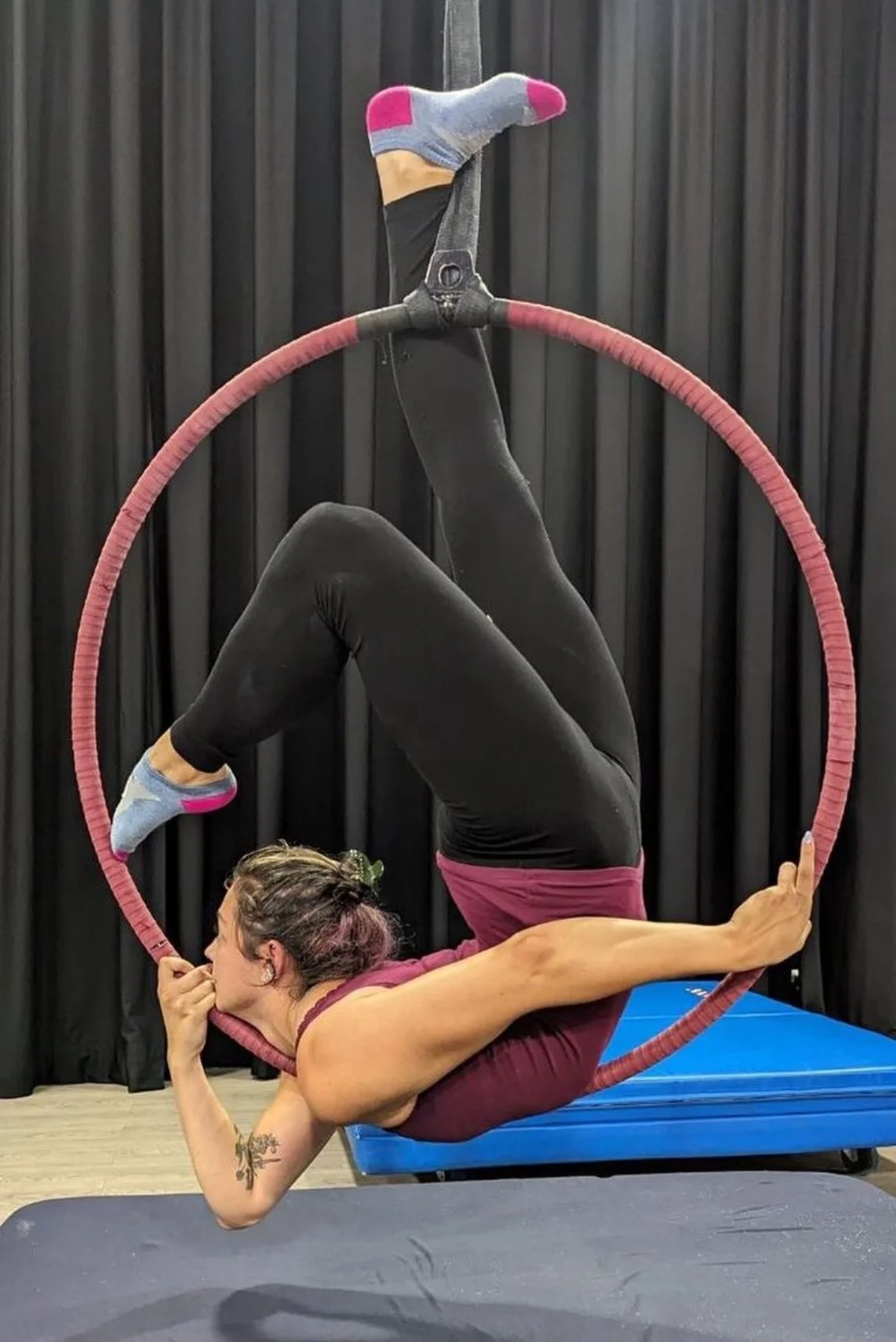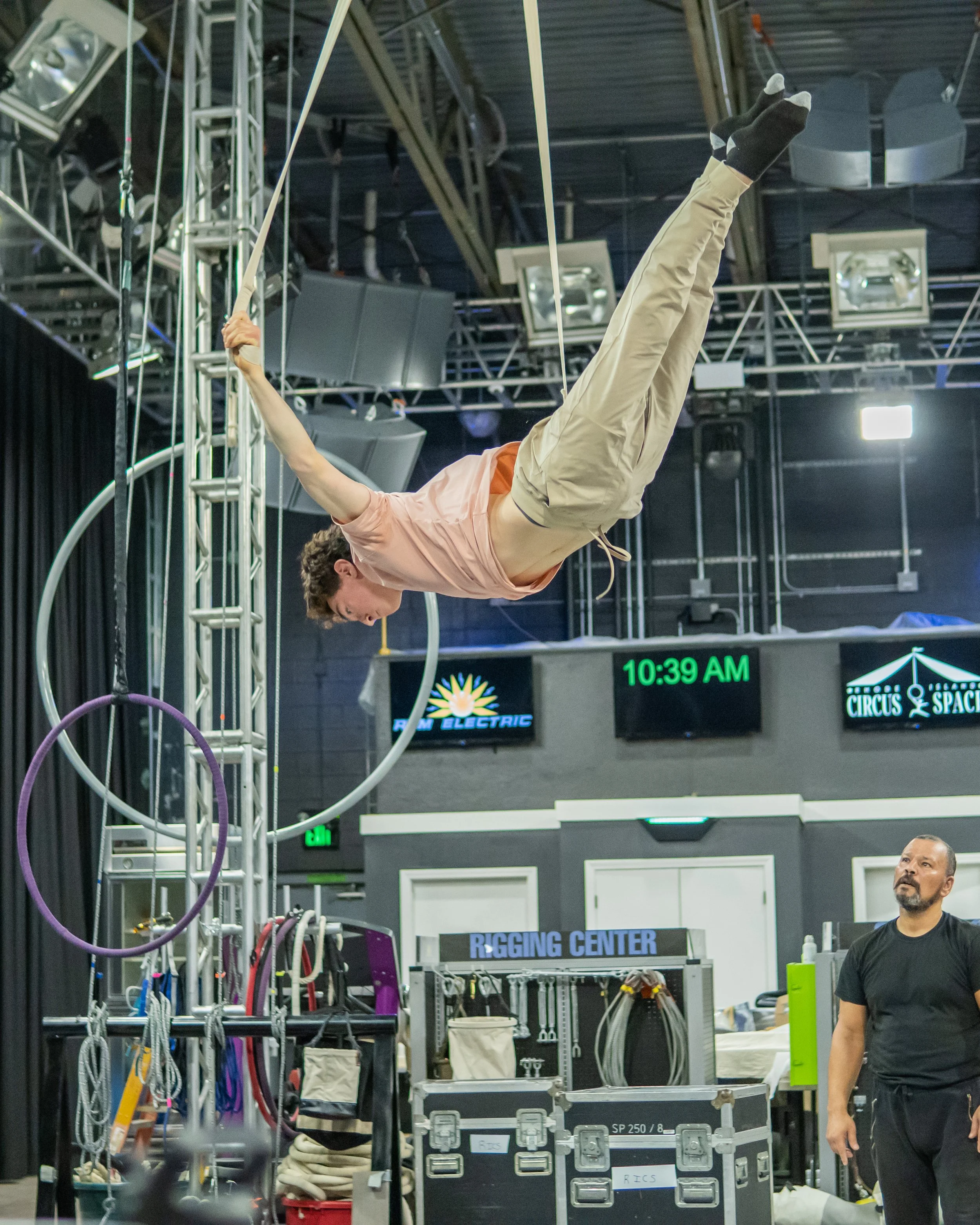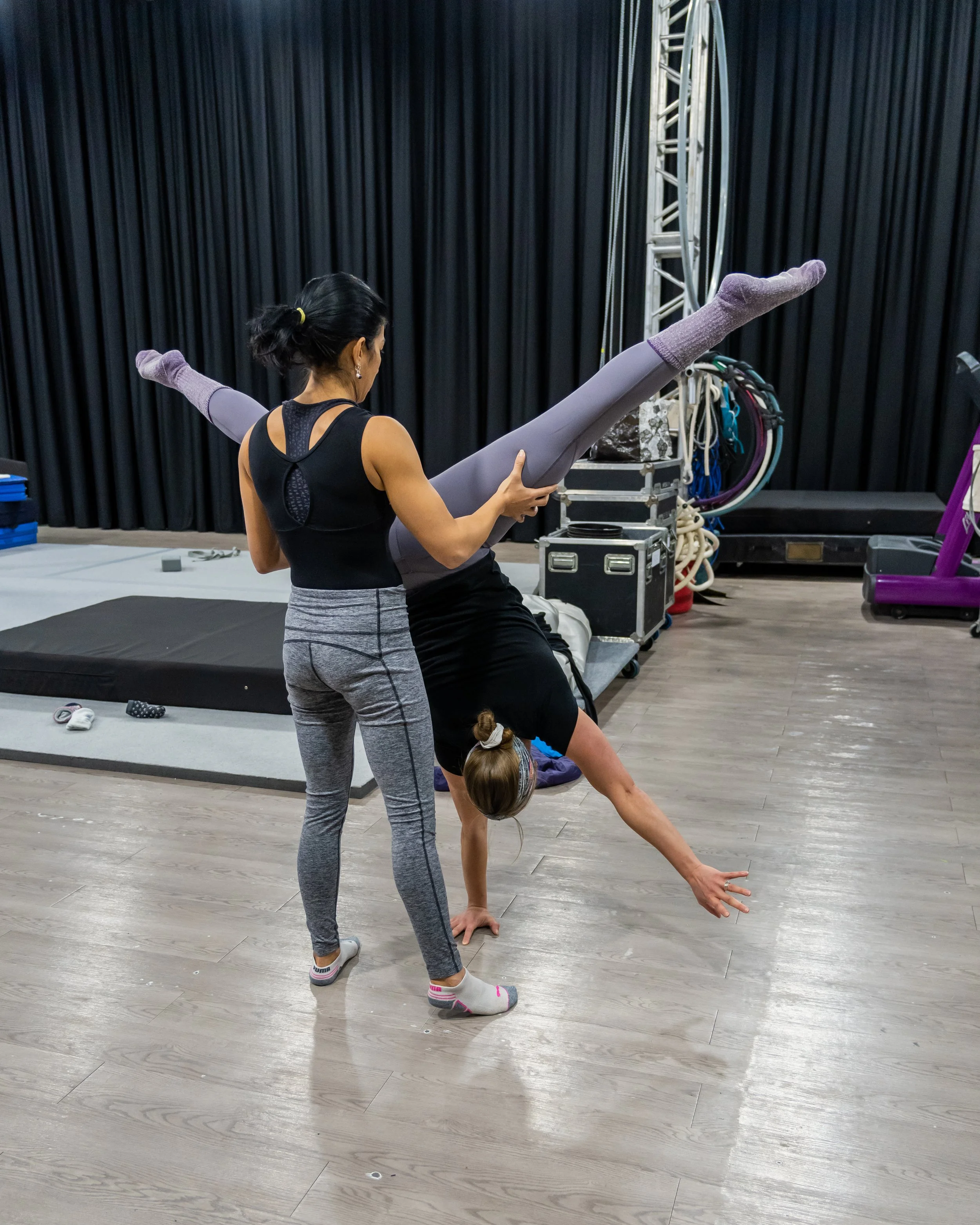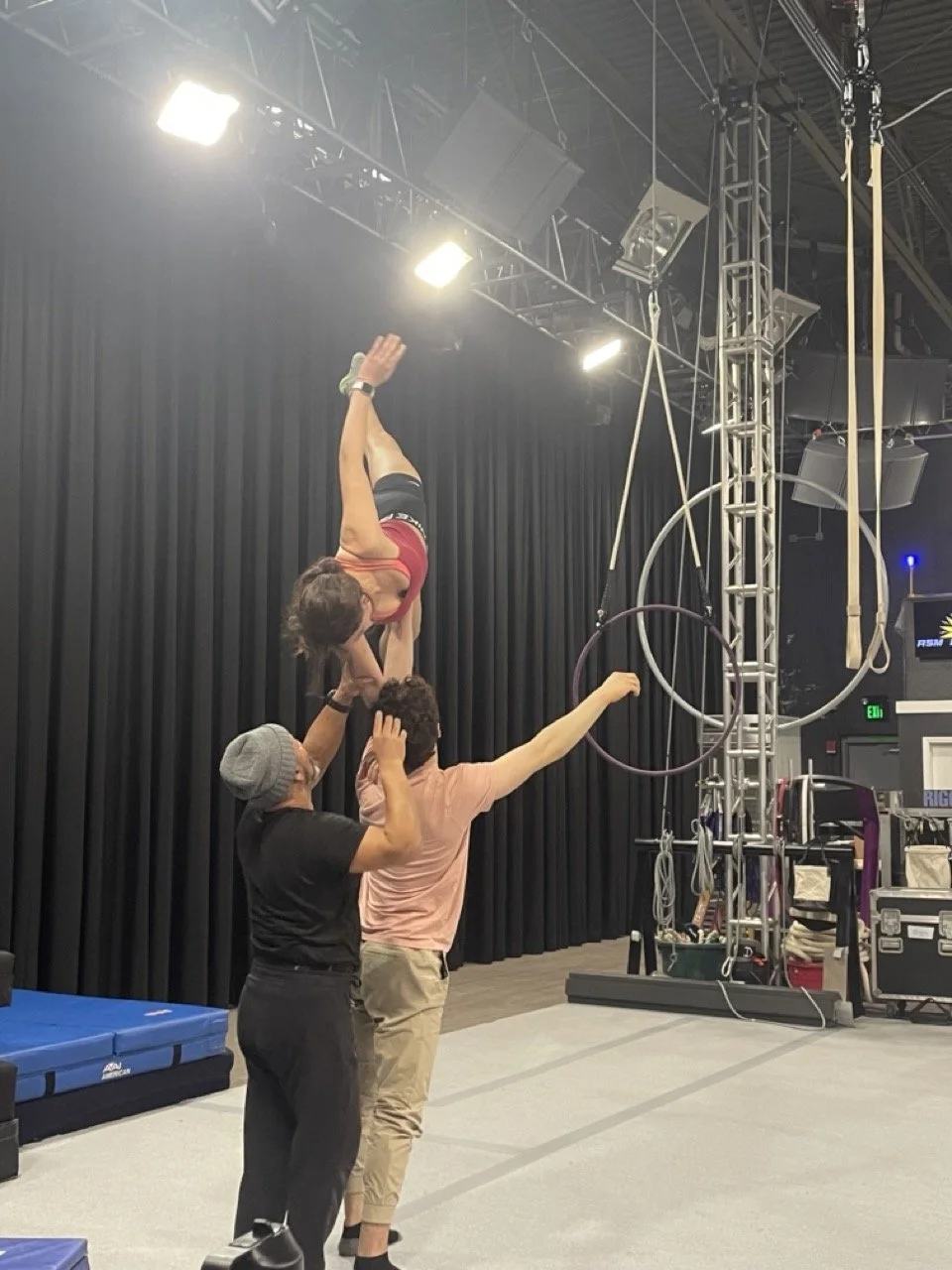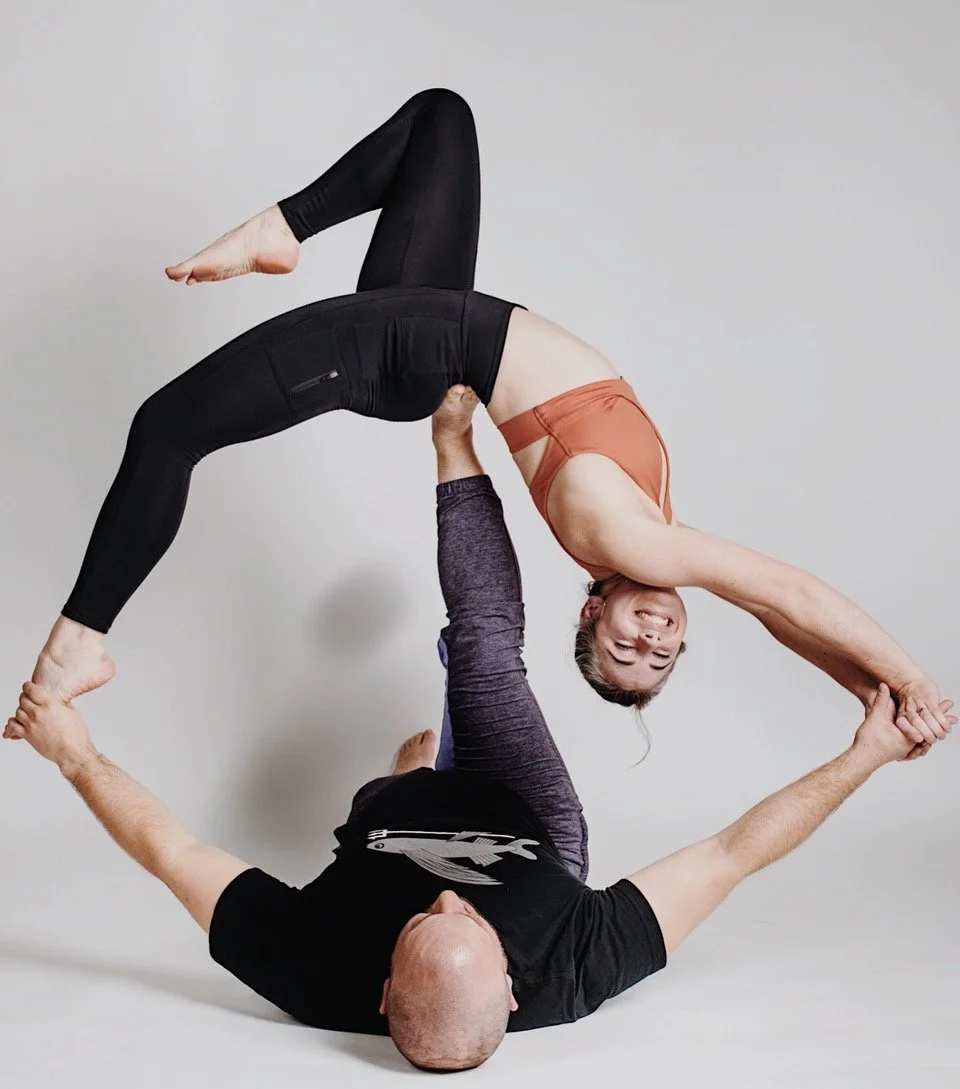-
![]()
Intro to Fabric or Lyra
An introductory class on vertical or bar apparatus for students who have little to no experience in movement arts or group fitness, such as dance, gymnastics, or yoga. This class is designed to provide a gentle introduction to the various aerial apparatus, and students are encouraged to try out each one in order to familiarize themselves with the basic conditioning and terminology that are necessary to prepare for a Level 1 aerials class.
Students will have the opportunity to work on basic conditioning exercises and techniques that are specific to each apparatus, such as silks, sling, lyra, or trapeze. These exercises may include ground based strength training as well as basic climbs, wraps, and poses that help to build strength, flexibility, and coordination.
-
![]()
Mixed Aerials
In a mixed aerials class, students will have the opportunity to work on multiple aerial apparatus such as fabric, lyra and/or trapeze. This means that within a single class, students may have the chance to try out different apparatus and learn new skills on each one. Alternatively, students may take a series of classes that focus on one particular apparatus, and then move on to another in a later class or session.
The specific level of the class generally indicates the level of difficulty and the prerequisites for the class.
Level 1 : An introductory level class that is suitable for new aerialists who have a regular fitness practice. These classes cover foundation skills and techniques on vertical and bar apparatus.
Level 2-4: Classes are intended for aerialists who have already gained competency on at least one aerial apparatus. These classes may build on the foundational skills learned in Level 1 classes and introduce more advanced concepts or a specialized focus, such as act creation.
-
![]()
Aerial Fabric
Aerial fabric or silks are long pieces of fabric that hang from the ceiling to the floor. There are four levels of skill development in aerial fabric training:
Level 1: Students will learn foundation skills such as climbs, inversions, simple poses, introduction to hip keys, and work on building strength and flexibility.
Level 2: Students will continue to develop their beginner skills while developing stamina linking two skills together, beginner rolls such as single stars, and more complex poses and transitions.
Level 3: Students will learn more advanced skills such as wheel downs, stacked drops, multiple belay entries, complex climbs, and straight arm inversions, swivels , and beats while continuing to build endurance.
Level 4: Students will focus on skills such as C-shaping, balances, open drops, and increase their understanding of fabric theory.
-
![]()
Aerial Lyra
Lyra, or aerial hoop, is a circular metal bar that is suspended from a single or double spinning point and is used in aerial dance or acrobatics.
Level 1: Students who are new to this apparatus will work on building strength and flexibility while learning foundational skills. These skills may include static poses and an introduction to beats (movements in which the person swings their body on the apparatus).
Level 2: Students will build on the skills learned at the previous level by expanding on static poses and beats, and adding rotations and beginning sequencing (linking together multiple skills in a sequence). It is generally expected that students have already gained competency in Level 1 skills before moving on to this level.
Level 3: Students will focus on adding drops, hangs, spins, and increasing endurance for sequencing. This class is more challenging and builds on the skills learned in the previous levels.
-
![]()
Aerial Rope
Aerial rope, also known as corde de lisse, is a vertical sheathed rope that is suspended from a single point and is used in aerial dance or acrobatics. This apparatus can be more challenging to work with than aerial fabric, such as silks, as it requires a greater degree of strength and control.
Aerial rope lessons are typically offered as private lessons, workshops, or in higher level mixed aerials classes. These classes are suitable for aerialists who have already gained competency on another aerial apparatus, such as aerial fabric, and are looking to challenge themselves with something new. It is recommended that students have established the strength and skills learned in Levels 1 and 2 of fabric before moving on to aerial rope.
There are some crossover skills between aerial fabric and aerial rope, as both involve climbing and wrapping techniques, but there are also elements more often seen on rope. For example, aerial rope may involve more precise footwork (ie, toe climbs) and increased grip strength, as well dynamic beats and catch and release movements.
-
![]()
Aerial Hammock
Hammock, also known as sling, is a length of fabric that is suspended on each end to form a loop. This apparatus is similar to traditional aerial fabric but offers more support to the aerialist. It is important to note that aerial hammock is not the same as aerial yoga, which uses a similar apparatus hanging from separated points on a lower ceiling and is intended to assist with yoga poses. Circus style aerial hammock incorporates acrobatics that are more similar to other vertical aerial disciplines.
Level 1: Students who are new to this apparatus will work on building strength and flexibility with the support of the fabric hammock while also learning the foundations of inversions. This class will focus on static poses. Level 1 hammock may be booked as an introductory class.
Level 2: Students will build on the skills learned in Level 1 by using the full length of the hammock for more advanced poses, drops, and sequences. The student will gain experience moving through sequences while spinning. The hammock may also be higher off the ground than in a Level 1 class.
-
Dance Trapeze
Dance trapeze is a straight bar apparatus that is suspended by ropes to a single spinning point and is used in aerial dance or acrobatics. This apparatus can have some crossover skills with other aerial apparatus such as lyra (aerial hoop) and fabric (silks), particularly when using the ropes.
Level 1: Students who are new to this apparatus will work on building strength and flexibility while learning basic skills common on bar apparatuses. These skills include static poses (poses that are held in place) and an introduction to beats (movements in which the person swings their body on the apparatus).
Level 2: Students will build on the skills learned in Level 1 by expanding on static poses and beats, and adding rotations, beginner sequencing (linking together multiple skills in a sequence), and small drops (controlled descents from the apparatus). This class is generally more advanced than Level 1 and introduces more challenging skills and techniques as well as familiarizing with sequencing while spinning.
-
![Contortion in aerials]()
Contortion
Photo: Contortion in an aerial lyra
Contortion is a specialized form of physical performance art that involves extreme flexibility, where individuals showcase their ability to bend, twist, and contort their bodies into remarkable and seemingly impossible positions. These positions can be both static (held for a period) and dynamic (involving fluid movements). Contortionists are typically featured in circus performances, dance routines, and other entertainment acts, where their extraordinary flexibility is highlighted. Contortion requires rigorous training, including extensive stretching and conditioning, to achieve the exceptional level of flexibility and control necessary for this art form.
Contortion begins with active flexibility and increasing range of motion while learning to understand ones own body. This element often compliments or is featured in combination with other aerial or ground disciplines.
Intro to Contortion
Anyone can do it! You don’t have to be extremely flexible to work on contortion. This intro class is all about working on becoming more flexible and gaining strength in your flexibility. It might feel intense at times but is all about pushing yourself in your own realm of flexibility. We will work on getting our splits, bridges and celebrate personal progress. This class will also build body awareness which can translate well throughout the rest of your circus work. -
Aerial Straps & Straps Conditioning
Aerial straps are a type of apparatus used in aerial dance or acrobatics that consists of two long straps (cotton or nylon, sometime sheathed in suede) that are hung from a spinning single point. Aerialists use these straps to perform a variety of skills including inversions, balances, and dynamic movements such as swings, flips, and drops. Straps are typically used in intermediate to advanced level classes, as they require a certain level of strength and control.
Straps conditioning class is a type of aerial fitness class that focuses on enhancing strength and conditioning for aerial work on any apparatus. This class is suitable for students who are already at Level 3 or higher on another apparatus or for those who are new to aerials but have a solid baseline of upper body and core strength.
In order to participate in this class, students need to meet certain prerequisites, such as being able to perform 3 full extension pull-ups with good form, 10 push-ups (not modified), 5 consecutive tuck rocks, a 1 minute hollow hold a and a 1 minute plank.
-
Hand Balancing
Hand balancing, or handstands, class is a type of ground based fitness class that focuses on developing upper body strength and balance through various exercises . The class typically begins with a warm-up that includes stretching and conditioning exercises for the wrists, forearms, shoulders, and core.
The instructor introduces students to basic hand balancing techniques, such as the handstand and helps them practice these positions with proper form and alignment. As students progress, they may learn more advanced techniques, such as handstand push-ups, one-arm handstands, and various transitions between positions.
Hand balancing class offers a unique way to build strength, coordination, and confidence.
Ability to kick up to a supported handstand is required, otherwise all levels are welcome.
-
![]()
Partner Acrobatics
Partner acrobatics is a form of physical activity that combines elements of gymnastics, hand balancing, and yoga, and is performed with a partner or partners. In a partner acrobatics class, students will learn how to support and be supported by their partner(s) as they execute a variety of poses and transitions.
At the beginning of a partner acrobatics class, students may start with light weight-bearing exercises with their partner in order to learn proper positioning and weight distribution. This may involve learning where it is safe to put weight on a partner's body and what areas should be avoided in order to minimize the risk of injury. As students become more comfortable and confident in their skills, the class may progress to more challenging combinations that involve greater strength, coordination, and balance.
It's important to note that the specific skills and techniques covered in a partner acrobatics class will depend on the instructor offering the class.
Partner acrobatics can be a fun and rewarding activity for those who are interested in working in partnership with others to explore new challenges and push their physical limits.
-
![]()
Tumbling
Circus tumbling is a dynamic form of acrobatics often seen in circus performances, involving flips, somersaults, and other high-energy movements executed with precision and grace. Acrobats require strength, agility, and coordination to perform these ground-based tumbling routines. Tumbling classes improve physical conditioning by enhancing strength, flexibility, balance, and cardiovascular fitness while also developing spatial awareness, orientation, and problem-solving skills. These benefits are valuable not only for acrobatics but also for various sports and physical activities.
Tumbling Level 1
A class for learning the basics of tumbling acrobatics. We will focus on the development of jumps, rolls, cartwheels, roundoffs, walkovers, etc.
This is a foundation class to develop form and body awareness. It’s a good way to challenge and move your body and an expected discipline for those interested in progressing in circus arts.
No experience needed.
Tumbling Level 2
A class for learning more advanced tumbling skills. We will focus on the development of front & back handsprings, front & backs flips, skill combinations, etc.
Pre-requisites: Must have a solid roundoff and forward roll.
Approval or invitation by instructor is required to attend this class.
-
![]()
Open Training
Open training is a session, usually 2 hours in length, offered to students who are already at Level 2 or higher on their chosen aerial apparatus. This type of training is an opportunity for students to practice and work on their skills without the direct guidance of an instructor, though one will always be supervising to ensure a safe environment for the participants.
Level 1 students may be able to attend independent training sessions with prior approval from the supervising staff. It is expected that participants in independent training have already completed at least 10 lessons within a 6 month period (excluding intro level classes) in order to participate. This is to ensure that students have a sufficient foundation of skills and techniques to work on independently.
During open training, participants should only work on skills that they have been taught in a class or lesson setting with an instructor. Instruction between participants is prohibited, as the focus of open training is on individual practice and improvement.
-
![]()
Private Lessons
Private lessons are a 1 hour session students can schedule individually or as small group. These are a learning opportunity with an instructor of their choice at a time that fits their schedule. Students can focus on a specific discipline and the lesson is tailored to the student's individual learning style and pace. Private lessons can be a valuable and rewarding way to learn and progress.
These are a great option for those who are looking for a more personalized and focused learning experience. They can be particularly helpful for students who are new to circus arts and want to build a solid foundation or for those who are looking to advance their skills and are seeking more intensive instruction. Private lessons can also be a good option for students who have specific goals or challenges that they want to work on, or for those who have busy schedules and prefer to schedule their lessons at a time that is convenient for them.
-
![]()
Strength Training for Circus Arts
This class is a ground-based fitness class that incorporates the use of weights, bands, loops, and body weight resistance training. Aerial apparatuses will often be used as a training tool but students will not be asked to be more than a step from the ground. The focus of the class is on building strength specifically for circus arts, making it an appropriate intro level class for new students who are looking to build strength, coordination, and balance.
It's important to note that the specific skills and techniques covered in this class will depend on the instructor offering the class. Ground-based fitness classes can be a great way to build strength and improve overall conditioning, and incorporating the use of aerial apparatus can add an additional challenge and element of fun to the workout.
-
![]()
Circus "Jam" Session
Jam sessions are informal gatherings that allow participants to explore and practice a variety of circus or movement arts skills in a relaxed and supportive environment. These sessions can have any focus that the community shows interest in, and could include activities such as juggling, handstands, straps, partner acrobatics, hula hooping, tumbling, stilt walking, aerial partnering, poi, and dance.
Jam sessions are often a great opportunity for participants to try out new skills or activities and have fun with friends, whether they are seasoned performers or new to the circus arts. These sessions can be a great way to build community and learn from each other, and may be hosted by experienced instructors or by members of the community who have a particular skill or passion they want to share.
It's important to note that jam sessions may vary in terms of structure and content depending on the host and the focus of the session. Jam sessions can be a fun and rewarding way to explore and expand your skills in the circus arts.
-
![]()
Acro Yoga
Acro Yoga is a dynamic and playful form of yoga that combines the elements of yoga and acrobatics. It involves two or more people working together to create a flowing sequence of yoga poses while also incorporating acrobatic moves and partner-based lifts. Acro Yoga is a challenging but fun practice that requires trust, communication, and teamwork between the partners.
Acro Yoga typically involves a "base" who remains in contact with the ground and a "flyer" who is lifted off the ground and supported by the base. The base provides a stable foundation for the flyer to perform various poses, while the flyer brings a sense of lightness and grace to the practice. Acro Yoga not only a physical practice but also a meditative and healing one.
Acro Yoga is suitable for people of all levels of fitness and experience and is great for families to practice together.







